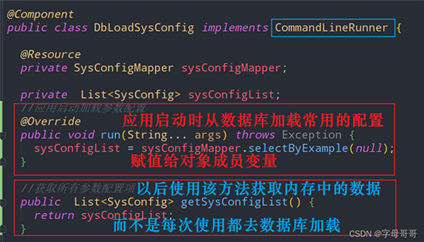
Spring Boot provides two interfaces: CommandLineRunner and ApplicationRunner, which are used to do special processing when starting the application. These codes will be used in SpringApplication The run() method is executed before the run is completed. Compared with the Spring's ApplicationListener interface custom listener and Servlet's ServletContextListener listener introduced to you in the previous chapter. The advantage of using both is that you can easily use application startup parameters and perform different initialization operations according to different parameters.
Implement the CommandLineRunner and ApplicationRunner interfaces. Usually used for special code execution before the application starts, such as:
Load system commonly used data into memory
The last time the application ran Garbage data cleaning
Sending notifications after successful system startup, etc.
I implemented the CommandLineRunner interface and loaded the system when the application started Commonly used configuration data is shown in the figure below. Load the data from the database into the memory. When using the data in the future, you only need to call the getSysConfigList method. There is no need to load the data in the database every time. Save system resources and reduce data loading time.

CommandLineRunner: The parameter is a string array
@Slf4j
@Component
public class CommandLineStartupRunner implements CommandLineRunner {
@Override
public void run(String... args){
log.info("CommandLineRunner传入参数:{}", Arrays.toString(args));
}
}ApplicationRunner: The parameter is Put it in ApplicationArguments and get the parameters through getOptionNames(), getOptionValues(), getSourceArgs()
@Slf4j
@Component
public class AppStartupRunner implements ApplicationRunner {
@Override
public void run(ApplicationArguments args) {
log.info("ApplicationRunner参数名称: {}", args.getOptionNames());
log.info("ApplicationRunner参数值: {}", args.getOptionValues("age"));
log.info("ApplicationRunner参数: {}", Arrays.toString(args.getSourceArgs()));
}
}This method can specify the execution order, pay attention to the first two Beans is CommandLineRunner, and the last Bean is ApplicationRunner.
@Configuration
public class BeanRunner {
@Bean
@Order(1)
public CommandLineRunner runner1(){
return new CommandLineRunner() {
@Override
public void run(String... args){
System.out.println("BeanCommandLineRunner run1()" + Arrays.toString(args));
}
};
}
@Bean
@Order(2)
public CommandLineRunner runner2(){
return new CommandLineRunner() {
@Override
public void run(String... args){
System.out.println("BeanCommandLineRunner run2()" + Arrays.toString(args));
}
};
}
@Bean
@Order(3)
public ApplicationRunner runner3(){
return new ApplicationRunner() {
@Override
public void run(ApplicationArguments args){
System.out.println("BeanApplicationRunner run3()" + Arrays.toString(args.getSourceArgs()));
}
};
}
}You can set the execution order through @Order
Add the following parameters to the IDEA Springboot startup configuration, save and start the application

Test output result:
c.z.boot.launch.config.AppStartupRunner : ApplicationRunner parameter name: [name, age]
c.z.boot.launch.config. AppStartupRunner : ApplicationRunner parameter value: [18]
c.z.boot.launch.config.AppStartupRunner : ApplicationRunner parameter: [--name=zimug, --age=18]BeanApplicationRunner run3()[-- name=zimug, --age=18]
c.z.b.l.config.CommandLineStartupRunner : CommandLineRunner incoming parameters: [--name=zimug, --age=18]
BeanCommandLineRunner run1()[--name =zimug, --age=18]
e=18]
BeanCommandLineRunner run2()[--name=zimug, --age=18]
The author has tested it many times It was found that in the test results, this priority order has always been like this, but it is currently impossible to determine whether this is the norm
ApplicationRunner execution priority is higher than CommandLineRunner
The priority of Runner running in the form of Bean is lower than that of Component annotation and implements Runner interface.
Order annotation can only guarantee the execution order of the same CommandLineRunner or ApplicationRunner, but cannot Cross-class guaranteed order
The core usage of CommandLineRunner and ApplicationRunner is consistent, which is used for special code execution before application startup. The execution order of ApplicationRunner precedes CommandLineRunner; ApplicationRunner encapsulates parameters into objects and provides methods for obtaining parameter names, parameter values, etc., which makes the operation more convenient.
This is a real problem that the author encountered in practice, that is, I defined multiple implementations of CommandLineRunner. A strange problem arises: When you define multiple implementations of CommandLineRunner, one or several of them will not execute.
Analysis: The following code is the code that SpringBootApplication will execute after starting the project. You can see that the CommandLineRunner or ApplicationRunner is started through a traversal in the code. In other words, the next CommandLineRunner will be executed only after the execution of the previous CommandLineRunner is completed, which is executed synchronously.
private void callRunners(ApplicationContext context, ApplicationArguments args) {
List<Object> runners = new ArrayList<>();
runners.addAll(context.getBeansOfType(ApplicationRunner.class).values());
runners.addAll(context.getBeansOfType(CommandLineRunner.class).values());
AnnotationAwareOrderComparator.sort(runners);
for (Object runner : new LinkedHashSet<>(runners)) {
if (runner instanceof ApplicationRunner) {
callRunner((ApplicationRunner) runner, args);
}
if (runner instanceof CommandLineRunner) {
callRunner((CommandLineRunner) runner, args);
}
}
}So, if a synchronous blocking API or a while(true) loop is called in the run method body of an implementation of CommandLineRunner, other implementations after the CommandLineRunner in the traversal will not be executed.
The above is the detailed content of How to implement monitoring of springboot application service startup events. For more information, please follow other related articles on the PHP Chinese website!
 SpringBoot project building steps
SpringBoot project building steps
 What is the difference between j2ee and springboot
What is the difference between j2ee and springboot
 java multithreaded programming
java multithreaded programming
 caj file opening method
caj file opening method
 How to register a permanent website domain name
How to register a permanent website domain name
 Summary of common socket errors
Summary of common socket errors
 What does it mean to connect to windows?
What does it mean to connect to windows?
 What are the calling methods of java reflection
What are the calling methods of java reflection




